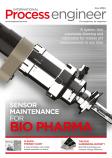Understanding explosion protection
Protection techniques in Europe
Ex ‘p’
• Ex pxb reduces the EPL (equipment protection level) in the pressurized enclosure from Gb (Zone 1) to non-hazardous (non-classified).
• Ex pyb reduces the EPL (equipment protection level) in the pressurized enclosure from Gb (Zone 1) to Gc (Zone 2).
• Ex pzc reduces the EPL (equipment protection level) in the pressurized enclosure from Gc (Zone 2) to non-hazardous (non-classified).
Ex p proves effective in safeguarding against explosions, especially when specific equipment protection levels need to be maintained within the enclosure.
Ex ‘m’
Electrical components that could ignite the surrounding atmosphere through sparks or heat can be made explosion-proof by fully embedding them in a casting compound. This compound must possess electrical, thermal, mechanical and chemical resistance.
The encapsulation materials are categorised into three levels: Ex ma, Ex mb, and Ex mc:
• Ex ma material ensures no ignition occurs during normal usage, in the event of a single fault, or when any two faults combine, making it suitable for use in Zone 0 or 20.
• Ex mb material guarantees no ignition during normal usage, even in the presence of a single fault, making it appropriate for Zone 1 or 21.
• Ex mc material ensures no ignition during normal usage, allowing its application solely in Zone 2 or 22.
By employing the appropriate level of encapsulation, electrical equipment can be made safe for operation in various hazardous zones, offering reliable protection against potential explosions.
Ex ‘o’
Ex o is an explosion protection method that involves submerging electrical devices or components in oil. By doing so, the potential for igniting an explosive atmosphere above the oil surface or outside the enclosure is eliminated. This ingenious technique ensures that any hazardous environment surrounding the oil-filled apparatus remains safe from ignition, offering reliable protection against explosion hazards.
Ex ’q’
The Ex q protection method involves filling a housing with a fine-grained filler to prevent any sparks or arcs that may occur within the enclosure from igniting the surrounding explosive atmosphere. Naturally, there are limits to the maximum allowable surface temperature.
Both the filler, such as sand, glass beads, etc., and the construction of the enclosure must meet the requirements set forth in the standard. The filler must never escape from the enclosure under any circumstances, whether during normal operation or after sparks or arcs occur within the sand-filled casing. Ex q is a reliable solution that ensures explosion hazards are effectively mitigated, offering a secure approach for industrial environments where explosion protection is critical.
Ex ‘e’
The Ex e protection method is designed with heightened safety measures to prevent the occurrence of unacceptable high temperatures, sparks, and arcs. This approach allows a potential gas mixture to enter the enclosure, requiring electrical equipment constructed under Ex e protection to exclude components capable of generating sparks or high temperatures during normal usage. With a focus on increased safety, Ex e ensures a secure environment in hazardous areas, providing a dependable solution that mitigates the risks of sparking and excessive heat in industrial settings.
Ex ‘i’
Ex i, or intrinsic safety, is an explosion protection method that limits the energy generated within the electronic circuits by employing intrinsically safe current levels. For a circuit to be considered intrinsically safe, the energy content must be restricted in such a way that sparks or any other thermal effects cannot ignite an explosive gas mixture. This limitation of energy is achieved by regulating both voltage (U), current (I), power (P), capacitance (C), and inductance (L) in the intrinsic safety circuits.
Intrinsically safe materials are categorised into three levels: Ex ia, Ex ib, and Ex ic:
• Ex ia material ensures no ignition occurs during normal usage, in the event of a single fault, or with any combination of two faults.
• Ex ib material guarantees no ignition during normal usage or in the presence of a single fault.
• Ex ic material ensures no ignition occurs during normal usage.
By adhering to strict energy limits, Ex i provides a reliable solution to prevent ignition risks in explosive environments, offering different levels of protection tailored to various industrial needs.
Ex ‘n’
Ex n is an explosion protection method designed to shield sparking contacts from the surrounding atmosphere and eliminate hot surfaces. This protection method is a collection of simplified variations derived from the previously mentioned protection methods, and it applies exclusively to Category 3G.
The key characteristics of this protection method are as follows:
• Ex nA: non-arcing, non-sparking: suitable only for normal non-sparking equipment (already replaced by Ex ec).
• Ex nC: closed construction: prevents contacts in voltage and current-carrying circuits from becoming potential ignition sources. This category also includes simplified pressure-resistant encapsulation.
• Ex nR: restrictive breathing, limited breathing enclosure to prevent the ingress of hazardous atmosphere.
• Ex nL: limited energy (already replaced by Ex ic).
Ex n presents a versatile set of protection techniques that effectively prevent sparking and potential ignition sources, making it suitable for various industrial applications where non-sparking equipment is essential to ensure safety in potentially explosive environments.
Temperature classification
Both European and North American systems consider temperature classification for hazardous area equipment. This classification indicates the maximum surface temperature produced under fault conditions. The temperature codes and typical substances for each code are shown in Table 2.
Ensuring safety in hazardous areas with effective explosion protection
Explosion protection is crucial in hazardous areas to prevent catastrophic events. European and North American standards provide guidance and certification processes for electronic and electrical equipment. By employing appropriate protection techniques and adhering to temperature classification, industries can ensure the safety of personnel and facilities in potentially explosive atmospheres.


















